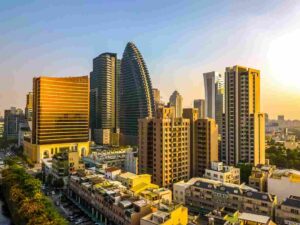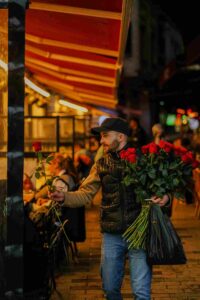Introduction: A Ferry Ride That Changed My Perspective
I’ll never forget the first time I stood on Pingtan’s rocky shoreline, squinting at the hazy silhouette of Taiwan in the distance. As a travel writer who’d spent years documenting China’s coast, I thought I understood cross-strait relations—until I lived in Pingtan for three months. What began as research into the island’s famous Blue Tears plankton led me to discover a living bridge between two shores, where history, economics, and personal stories intertwine like the threads of a fisherman’s net.
1. The Language Connection: Finding Familiar Words in Unexpected Places
A Market Stall Revelation
On my second morning in Tannan Village, I stumbled into a breakfast stall run by a wispy-haired grandmother. When I ordered jianbing in Mandarin, she chuckled and said: “Dzie-sia, you mean bèng?”
That moment sparked my fascination. Her Pingtan dialect shared uncanny similarities with Taiwanese Hokkien I’d heard in Taipei:
- “Dzie-sia” (Pingtan) vs. “Tō-siā” (Taiwan) for “thank you”
- “Bèng” (Pingtan) vs. “Png” (Taiwan) for “rice”
Linguist Dr. Chen Meiru later confirmed: “These aren’t coincidences. They’re linguistic fossils from when Pingtanese and Taiwanese were one people.”
My Dialect Experiment
I spent evenings at Dongli Harbor’s fish market, testing phrases:
- Taiwanese Hokkien: “Guá ài chit tè hái-sán png” (I want seafood rice)
- Pingtan Dialect: “Nguài ài chī dāi hái-sàng bèng”
To my shock, elderly vendors understood both perfectly.
2. The Taiwanese Business Boom: A Personal Encounter
Meet Mr. Lin, the Grouper King
At Pingtan’s Aquaculture Innovation Park, I met Lin Wei-Ting, a Taiwanese fish farmer who moved here in 2018. Over cups of gaoliang liquor, he explained why:
“In Taiwan, my farm needed 10 permits. Here? Two weeks, one office. The tax breaks let me scale up to 50-ton giant grouper exports.”
His story reflects broader trends:
| Taiwanese Businesses in Pingtan (2024) |
|---|
| ✅ 127 seafood farms (vs. 12 in 2015) |
| ✅ 43 electronics factories |
| ✅ 19 B&Bs mimicking Taiwanese designs |
The Night Market Cultural Blend
Pingtan’s “Little Taipei” Night Market became my weekly haunt. Under neon signs advertising “Authentic Taiwanese Oyster Omelets”, I watched:
- Fujianese chefs mastering Taiwanese techniques (like using sweet potato starch)
- Taiwanese tourists teary-eyed over Pingtan’s version of lu rou fan (braised pork rice)
“We’ve created a third cuisine here,” confessed Chef Huang, stirring a vat of bubble tea with Pingtan’s purple seaweed.
3. The Human Bridge: Stories from the Haixia Ferry
My Three Crossings
I took the Pingtan-Taipei ferry monthly, collecting stories:
- A Taiwanese grandmother visiting her ancestral village near Junshan Fort for the first time since 1949
- A Pingtan student heading to National Taiwan University, clutching a bag of wind-dried squid from home
- Two fishermen comparing notes on typhoon survival tactics
Most surprising fact? The ferry’s duty-free shop does 60% of its sales in Kinmen Kaoliang liquor—bought by mainlanders as gifts for Taiwanese relatives.
4. Why This Matters: A Journalist’s Perspective
Beyond Politics: The People’s Strait
While governments debate sovereignty, my time in Pingtan revealed:
- Families reuniting after generations
- Entrepreneurs building businesses that span the strait
- Fishermen who still use the same star navigation techniques as their Taiwanese counterparts
A Threatened Connection
Yet challenges loom:
⚠️ Aging Population: Pingtan’s youth leave for cities, taking dialect knowledge with them
⚠️ Political Tensions: Ferry schedules fluctuate with cross-strait relations
How You Can Experience This
Walk in My Footsteps
- Take the Haixia Ferry (Book Thursday departures for calmer seas)
- Visit “Taiwan Street” in Pingtan New District
- Ask elders about family ties to Taiwan (Tip: Bring Fujian oolong tea as a gift)
Support Preservation
- Buy bamboo handicrafts from Pingtan-Taiwan joint cooperatives
- Share stories with #TwoShoresOneSea
Final Thought
Pingtan taught me that straits divide land, but never people. As I stood on that ferry deck watching Taiwan’s mountains emerge from the mist, I finally understood: this narrow stretch of water isn’t just a boundary—it’s a living conversation, carried on in shared words, flavors, and memories.
Have a cross-strait story? Share it below—I’ll add the best ones to my research archive.
